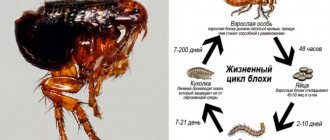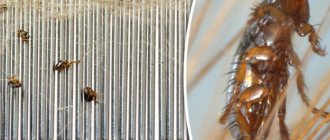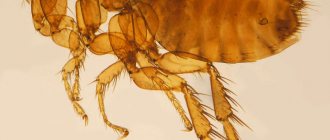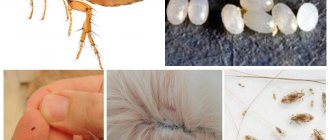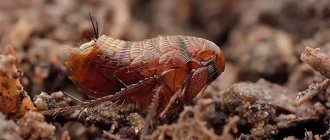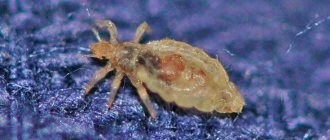- Lifespan
Fleas are perhaps one of the most famous small parasitic insects. They cause the most harm and trouble to our pets: cats and dogs, but they can also be dangerous for humans, since in some cases fleas can be carriers of dangerous diseases such as pseudotuberculosis, listeriosis, and tularemia. What are the habits of these little parasites, what does a flea look like, where does it live, how to fight fleas, read about all this further.
Description, structure, characteristics
What do fleas look like? The body length of a flea is only 1-5 mm, but sometimes females of certain flea species can be much larger, up to 1 cm, especially after intensive feeding. Due to nutrition, the size of their abdomen increases, and the flea itself, as a result, increases in size. Usually the largest fleas, measuring more than 1 cm, parasitize moose and deer.
The flea's body, consisting of the abdomen and head, is covered with a durable chitinous covering. When looking at a flea through a microscope, you can see how much the body of this insect is flattened laterally. Perhaps in some ways the flea even resembles a shrimp, only several times smaller. In fact, this shape of the flea’s body is justified by evolution itself, thanks to which the flea can easily penetrate animal fur, bird feathers, and even the folds of human clothing.
What color are fleas? The color of the flea can be reddish, yellowish, dark brown or completely black.
The flea does not have wings, and as a result cannot fly, but it jumps well. However, wings would only hinder her movement inside animal fur. The flea gets on the body of animals exclusively with the help of high and distant jumps, which are carried out due to the strong push of the second and third pairs of their legs.
The flea is also covered with numerous spines and bristles, which are scattered throughout the body, and on its head there are jagged combs - ctenidia. Thanks to this structure of the flea's body, it is very difficult to comb it out, pull it out or bite it out. It can only be destroyed by crushing it with a fingernail on a hard surface.
The flea's eyes, like those of other insects, are located on the head, and behind them there are antennae, with the help of which male fleas catch females during the mating season. These antennas are immersed in small antennal fossae.
Fleas have a piercing-sucking type of mouthparts, how does this manifest itself? The flea bites through the skin of the host (on whose body it parasitizes), widens the wound and releases saliva into it, which prevents blood clotting. Then she dives into the wound herself, trying to get to the blood vessels. By feeding on blood, fleas fill their stomach, which tends to swell greatly.
Among other things, all fleas have a special sensory organ - the pygidium, which is located in the back of their abdomen. The tactile hairs of the pygidium are capable of sensitively detecting even the slightest vibrations in the air, warning the flea of potential danger.
The female flea has reproductive organs consisting of the testicle, oviduct and spermatheca, while males have a copulatory organ - the genital claw.
Appearance of linen fleas
Based on the fact that such a concept does not exist for science, we can form a collective image of these parasites. Most often, types of fleas infest bedding and upholstered furniture, which can find suitable food for themselves in apartment buildings:
- felines;
- canine;
- human;
- rat.
They all have a strong external resemblance to each other. The body dimensions of blood-sucking insects are very small, from 2 to 4 mm in length, so they are quite difficult to visually notice.
The entire body of a flea is covered with a dense chitinous covering, making it almost impossible to crush it. The body has a laterally flattened shape, which further prevents the capture of the parasite. The color ranges from brown to black. The hind pair of legs is very large and powerful, which allows the flea to make rapid jumps to great heights and lengths. The insect's body is covered with small bristles, which allows it to reliably cling to animal hair and fabric fibers.
Lifespan
How long do fleas live? The lifespan of a flea depends on its species and habitat, and can range from several months to three years. At elevated temperatures, when the air temperature is more than 30 C, the life cycle of the blocks is reduced by 40%. And at lower temperatures, the life expectancy of a flea, on the contrary, increases as its development slows down.
How long do fleas live without an animal or, in general, without a donor? Being outside the animal's body, the flea remains without food, but since these insects are capable of not feeding for a long time, the flea easily tolerates hunger for 30-40 days. At the same time, it can live for several months, although such a starving flea reduces its activity and stops reproducing.
Why are they dangerous?
Bites are characterized by manifestations of allergies.
Feeding on the blood of humans and small animals, fleas leave painful wounds on the body that are easily distinguished from the bites of other insects.
Petechiae appear on the skin - small hemorrhages. These red spots with a dark spot in the middle are painful and very itchy.
Flea bites cause an allergic reaction, especially in children and people with sensitive skin.
Victims may experience pulicosis or sarcopsillosis. These parasitic diseases cause swelling, pain, itching, and in severe cases, damage to the nervous system.
But the main danger from bed flea bites is the transmission of infectious diseases through the blood:
- hepatitis types B and C;
- bubonic plague;
- tularemia;
- typhus;
- encephalitis;
- tuberculosis.
Fleas can reproduce quickly, rapidly increasing their population indoors, so it is necessary to immediately respond to their appearance in order to prevent the consequences of the activity.
Habitats
Where do fleas live? Strong, hardy, these insects are common everywhere, even in cold
Antarctica, where they can successfully parasitize the same penguins and seals. Most of their species live in the temperate and subtropical zones of Europe, Asia, Africa, and the Americas. Fleas are active at any time of the year. They usually live near the nests and burrows of their potential donors: warm-blooded animals.
Folk remedies for flea control
Many people, especially those with small children, try to avoid using harsh chemicals. In such a situation, proven folk remedies will come to the rescue.
- Herbal mixtures from eucalyptus, tansy, mint, and wormwood are very effective. You can simply arrange bouquets of herbs indoors, or you can prepare a decoction and spray your apartment with it - insects cannot stand strong odors.
- Garlic has a similar effect. You can simply place fresh cloves around the rooms, or you can prepare an infusion and spray it throughout the apartment.
- Often, pillows filled with pine sawdust are laid out.
- Dried peel of any citrus fruit.
The appearance of fleas in the house is a serious problem. These insects can be carriers of many diseases, so it is important to get rid of them in a timely manner.
Nutrition
What do fleas eat? Fleas feed exclusively on the blood of their hosts, or donors, on whose bodies they successfully parasitize. The main victims of fleas are mammals, whose life at any time of the year is connected with the presence of a shelter. But animals that live in burrows and nests only periodically are less susceptible to flea attacks. Typically, fleas do not live on the body of their owner all the time, but jump there only to feed on their blood; having had their fill, they jump into the litter of a hole or nest.
Some fleas are associated with animals that do not have permanent housing at all; these types of fleas are stationary parasites, that is, once on the host’s body, they no longer leave it. These fleas include fleas that live on dogs and cats.
Unlike
mosquitoes, in which exclusively females are bloodsuckers, in fleas, both males and females suck blood equally. The process of saturation with blood can last from one minute to several hours. Sometimes fleas are saturated with blood in reserve, significantly inflating their abdomen.
Stationary fleas have a need for regular feeding, this is another reason why they do not leave the host’s body on their own. In between meals, they wander freely in the skin of their prey.
Interestingly, most types of fleas can parasitize different animals, for example, jump from a squirrel to a dog or cat. The only exceptions are fleas
bats that require only bats as hosts.
Prevention of bed fleas
Many consequences of flea activity in an apartment were described above, as well as ways to get rid of these insects. It is probably much easier to prevent the appearance of fleas at home than to fight them for a long time. And after all, preventive measures in this case are elementary.
The main mistake is overestimating the order of the house. It is generally accepted that such insects can only appear in dirty apartments, but in fact, even banal dampness is enough to provide fleas with a favorable environment for reproduction. Then there are heaps of dust on the shelves, crumpled things, and so on. An equally important factor should be considered pets, which account for a considerable part of the introduction of fleas into the apartment.
The apartment should be cleaned; animals need to purchase special collars or products.
Fleas are a problem of the distant past, as it may seem at first glance, but often even residents of clean apartments and modern homes experience an unpleasant feeling of goosebumps and bites during sleep, and in the morning they observe strange-looking marks on the body. It is much easier to prevent the appearance of these insects in your home than to spend months fighting the result of their uncontrolled reproduction.
Types, photos and names
Zoologists have identified up to 27 families of fleas; we will describe the most interesting of them.
human flea
It is the most common among fleas and lives everywhere. It is brown in color and 1.6-3.2 mm long. Moreover, this flea is capable of jumping to a height of up to 30 cm and half a meter in length. Unlike other fleas, it does not have thoracic or head teeth. It can parasitize various animals, including humans (hence its name). In addition to humans, it is often found in animals that have close contact with humans: primarily in cats, dogs and
horses. It is very dangerous, as it can carry the plague pathogen and cause pulicolosis - an itchy skin lesion.
Cat flea
Despite the name, this flea lives not only on cats, but also on dogs, rodents, and many other animals, sometimes even on humans. The cat flea has a short proboscis and a flat forehead, the body length is 0.75-5 mm.
Dog flea
This flea is a close relative of the cat flea, and can also live on dogs, cats and other animals, including humans. In appearance and size it is similar to a cat flea, the only difference is in life expectancy, if a cat flea lives up to 2 years, then a dog flea lives no more than 1.5 years.
Southern rat flea
This type of flea is especially dangerous because it carries plague, mouse and rat tapeworms. It lives everywhere, but to a large extent these fleas are common in areas with warm tropical climates. Females range from 1.8 to 2.7 mm in length, males are slightly smaller: 1.4 to 2 mm. They may be light or dark brown in color. Most often they parasitize rats and other rodents, living in their burrows or nearby.
Penetrating flea
She is also the sand flea or the Brazilian ground flea. Originally from Brazil and Haiti, this flea was eventually introduced to Africa, India and Pakistan, where it successfully took root. It has an oval-shaped body and a red-brown color with a white spot in the middle. The average body length of this flea species is 1 mm, and it is capable of jumping to heights of up to 30 mm. Usually lives in the grass, from where it jumps on animals, birds and humans. Penetrates under the skin of animals' feet. A person can penetrate under the nails of his toes and fingers, and lead to inflammation, tetanus, and in especially difficult cases, gangrene and amputation of limbs.
Use of chemicals
To kill parasites at home, you should resort to two types of poisons:
- Suspensions and powders. These contact substances penetrate the insect through the outer integument.
- Aerosols or sprays that poison bloodsuckers by penetrating them with air.
You can get rid of larvae that feed on organic residues using special dusts.
Aerosols and sprays
The use of any of this means involves preparing the premises and only after that – treating the house from parasites. The procedure for exterminating insects is as follows:
- People and animals are removed from the house. Aquariums are tightly closed with a lid. Dishes and food are hermetically packaged and hidden. The garbage is thrown away.
- Carpets are removed, furniture is moved away from the walls, and the room is wet cleaned.
- The person who will carry out the treatment puts on a protective mask, gown, and gloves.
- An aerosol, or a solution prepared from a concentrated insecticide, is sprayed wherever parasites usually hide. Particular attention should be paid to upholstered furniture, beds, animal bedding, doorways, cracks, floor joints, baseboards, and carpets.
- All windows and doors are closed, and the house is left for several hours. It is best to spray in the evening so that the insecticide acts on insects for as long as possible.
- Upon return, the house is ventilated. After this, you need to vacuum everything and carry out wet cleaning.
The duration of action of the drug depends on the type of drug. Most often, after some time, re-treatment of the room is necessary.
most often used to kill fleas:
The most effective insecticide concentrates are:
They are diluted strictly according to the instructions , poured into a bottle with a spray bottle and used for their intended purpose.
Powders and gels
These insecticides are much easier to use. Their use does not require a break from normal life. Powders and gels work for quite a long time. Their effectiveness will not be noticeable immediately. The parasites will begin to die only a few days after treatment at home.
The powders are scattered and the gel is spread behind cabinets, under sinks, along baseboards, near beds, under carpets. Before using them, it is advisable to carry out wet cleaning.
The disadvantage of gels and powders is that such products are not recommended for use in a home where small children and animals live.
Among the powders, one can highlight the drug Pyrethrum. It differs sharply from other insecticides in that it is made from medicinal chamomile inflorescences. The product has a powerful poisoning effect and is used to kill many insects. Pyrethrum powder is recommended for use in a room that has already been treated with liquid insecticides. It is poured into cracks, behind baseboards, and into corners.
Reproduction and development
Under favorable environmental conditions, fleas reproduce all year round. At extremely low temperatures, fleas will survive without problems, but will not reproduce. Also, for successful reproduction, both partners must be well-fed; hungry fleas will not reproduce.
During sexual intercourse, the female climbs onto the male's back and pulls his genital claw into her spermatic receptacle. Interestingly, sexual intercourse in fleas can last several hours, while it takes 10-15 minutes to transfer the seed to fertilize the female.
Some time after fertilization, the female lays eggs, which pass in small portions. Typically, fleas lay 1-2 servings of 4-10 eggs per day. The process of laying eggs itself is very curious: the female forcefully pushes out the eggs, which sometimes fly considerable distances from each other. This position of the eggs makes sense, since competition between the hatched larvae subsequently decreases.
Room treatment
To clean the room from blood-sucking pests, it is necessary to carry out a general cleaning of the room. It is necessary to clear the walls and floors of carpets and furniture and clean them thoroughly. Collect and throw away all trash.
Treatment is carried out after general cleaning of the premises.
Treat the room with chemicals, especially at the joints of the floor and baseboards, near the furniture. Close the room for 2-3 hours for the drugs to take effect. After disinsection, thoroughly ventilate the room.
Life cycle
Fleas are insects with complete metamorphosis, and their life cycle consists of the following stages:
Flea eggs when looking at them through
microscopes are very similar to grains of rice.
Egg development lasts approximately 14 days. Then worm-like and translucent larvae emerge from them, still without legs. Wriggling, they climb into the litter of the owner's nest. Flea larvae feed on rotting organic matter, skin epithelium, or the remains of undigested blood in the excrement of their parents.
After three lines, the larva turns into a pupa. The pupal stage, depending on the type of flea, can last from several days to several months; in some species of fleas at the pupal stage, fleas overwinter, and emergence from the cocoon is timed to coincide with the onset of spring warmth.
Having emerged from the pupa, the adult flea first begins to search for its owner.
What to do if bitten by a flea?
If you find flea bites on your body, do not scratch the affected areas of the body under any circumstances, but immediately wash them with running water and antiseptic soap. It is recommended to treat the bite site with calamine soothing lotion, but if this is not available, use alternative treatment methods.
You can treat the affected area of the body with water and apple cider vinegar. Mix the necessary ingredients in a 1:2 ratio and refrigerate. Soak a thin cloth in the cooled liquid and apply it to the bitten area.
A paste made from sodium bicarbonate and water relieves itching well. The resulting paste is applied to the bite site for 15 minutes. You can also prepare a liquid from 250 ml of water and lemon peel. The infused mixture is used to treat itchy areas.
Flea bites
Flea bites cause stabbing pain when the skin is pierced and a strong desire to scratch the bitten area. A characteristic swelling usually appears at the site of the bite, somewhat similar to that from a cigarette burn. After the flea has eaten and detached itself, the edges of the wound converge, preventing bleeding, and a pinpoint hemorrhage forms at the site of the bite.
The main method of protection against little bloodsuckers is the complete destruction of fleas at home + prevention from them and other possible parasites (the same
ticks) when going outdoors.
Calling a special organization
Despite the abundance of modern means designed to destroy parasites, in large concentrations of insects these control methods may be ineffective. How to get rid of a bed flea if self-use of insecticides does not bring the expected result?
To completely disinfect your home and eliminate parasites, it is recommended to contact specialists. Calling representatives of special services will allow you to get rid of all types of blood-sucking insects that are localized even in the most secluded corners of the apartment.
It is important to remember that after the treatment you should ventilate the apartment well, carry out a thorough cleaning, and also take measures to prevent the appearance of insects.
How to get rid of fleas in an apartment?
If you already have these parasites in your apartment, then the best remedy for fleas will be special insecticides that can destroy fleas even in the most neglected rooms. Since fleas could not even physically eat poisonous bait, means of combating them are made in the form of sprays, powders and suspensions that affect the nervous system of fleas.
When treating a room with aerosol preparations, it is necessary to temporarily evacuate all the inhabitants of the house, and then thoroughly ventilate the room and do a thorough wet cleaning.
Among the best flea medications are:
- Raptor spray with a pleasant mint scent. It is safe and effective; usually two cylinders are enough to treat a one-room apartment.
- Sinuzan is an effective and professional remedy for fleas. Its disadvantage is the unpleasant smell.
- Biorin is a professional product that destroys not only fleas, but also other insects and parasites.
After exterminating fleas, you should definitely do a general wet cleaning of the house, and generally monitor cleanliness, since unsanitary conditions and dirt are the most favorable environment for these insects.
Ways to get rid of parasites
If your home is not yet heavily infested with parasites, you can remove them using the following measures:
- Since fleas mainly live in the bed, the linen should be washed in hot water or destroyed.
- Pets should be examined for the presence of parasites and their eggs in their fur. To repel insects, you can use flea collars, shampoos, drops or sprays. It is best to throw away your pet's bedding.
- Place wormwood or tansy in the corners of the house. The smell of these herbs will repel bloodsuckers. You can apply a solution of essential oils of mint, eucalyptus, clove or lavender around sofas and beds. Insects don't like their smell either.
If the above procedures did not help get rid of parasites, then you need to use special means.
Interesting Facts
- In the 17th-18th centuries, fleas were so common among the French nobility that French aristocrats even had special items for catching fleas, so-called “flea traps,” which were small boxes like a medallion with a small hole into which fleas could accidentally fall.
- It was fleas that caused terrible epidemics of bubonic plague in the Middle Ages, which claimed many human lives. The plague fleas themselves were carried by rats and mice.
- Fleas are true jumping champions among insects; the length of a flea's jump can exceed the length of the flea itself by 100 times! Only cicadas jump further than fleas in relation to body length.
- The first serious scientific study of fleas began in the 19th century. A great contribution to their study was made by a certain Charles Rothschild, a wealthy English banker and part-time entomologist. He also collected the world's largest collection of various fleas, which is now kept in the British Museum.
Video
Author: Pavel Chaika, editor-in-chief of Poznavaika magazine
When writing the article, I tried to make it as interesting, useful and high-quality as possible. I would be grateful for any feedback and constructive criticism in the form of comments on the article. You can also write your wish/question/suggestion to my email [email protected] or Facebook, with respect, the author.
Author page
This article is available in English -
Fleas.
Bed linen and mattress care
To reduce the risk of parasite reproduction, special attention should be paid to the sleeping area - there is a large accumulation of bed fleas due to the availability of food. It is important to periodically clean the mattress cover, vacuum the bed, and change bed linen regularly.
If disinsection has been carried out previously, all laundry must be washed at high temperatures. There may have been flea excrement, larvae, or dead adults in the laundry. Washing is necessary to prevent bed fleas or allergic reactions.


